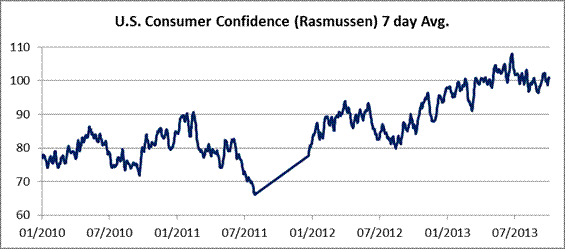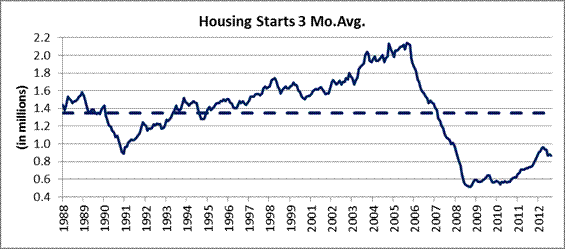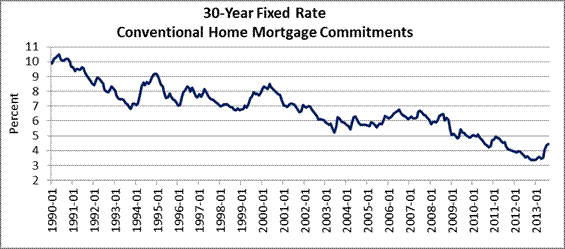As we write this outlook, our political leaders once again have succeeded in holding the U.S. government budget, and by extension the financial markets and the broader economy, hostage to their respective political agendas. We believe it is important to avoid getting caught up in the drama on Capitol Hill and remain focused on the slow but continued healing taking place in the U.S. economy. This was our advice a year ago at the height of the fiscal cliff uncertainties and again earlier this year heading into the sequestration battle. In both instances, it paid to remain invested and not get distracted by the political drama in Washington, D.C. Increased market volatility can be expected as long as the battle rages on in D.C. This may even be a reasonable excuse for the stock market rally of the past 15 months to take a breather, but we doubt that there will be any material damage done to the U.S. economy from the current partial government shut down. Consequently, once the political dust settles surrounding the budget and the debt ceiling, we think that equity markets will resume their upward bias.
The bullish argument for remaining invested in equities, even after the strong market rally over the past four years, hinges on a potential acceleration in U.S. economic activity in 2014 and 2015 driven by continued recovery in housing and construction markets, demand growth for other non-durable goods, recovery in corporate capital spending and continued growth in broad-based consumer spending. Even though interest rates have backed up somewhat from unsustainably low levels earlier this year, credit conditions continue to improve with consumer, corporate and financial sector balance sheets all in either good or great shape. The sharp rebound in home and stock prices has helped to restore both consumer net worth back to pre-2008 levels and confidence along with it (Figures 1 and 2). As the employment backdrop continues to improve gradually, household formation should recover back to more normal levels and support meaningfully higher home construction levels given the very low levels of housing starts since the financial crisis (Figure 3). There is some concern that the recent spike in mortgage rates could derail the housing recovery already underway, but our sense is that most borrowers will still view interest rates as low by historical standards (Figure 4).
Figure 1:

Source: ISI (Data end date: September 30, 2013)
Figure 2:

Source: ISI (Data end date: October 2, 2013)
Figure 3:
Average: 1.35

Source: ISI (Data end date: August 31, 2013)
Figure 4:

Source: Federal Reserve (Data end date: August 31, 2013)
Based on projections from J.P. Morgan, we do not believe that growth in 2014 and 2015 will experience the same drag from the fiscal tightening (sequestration and tax hikes) that has likely held back the economy this year. At the same time, recent data indicates that growth in the rest of the world is beginning to rebound. An eventual global reacceleration in economic growth would likely lift corporate profit growth from the current sluggish 3-5% growth rate. Given the slack in labor markets, generally benign commodity markets and plenty of underutilized factory capacity, we think the odds are that this next phase of economic growth can occur against the backdrop of continued low inflation. If we are correct, this may allow the Federal Reserve (Fed) to keep interest rates low for the next several years. The potential therefore exists for both earnings and multiples to rise further from current levels.
One of the major wildcards that could detract from this relatively rosy scenario is the role of the Fed’s quantitative easing (QE) program. It is well understood by markets that Fed Chairman Bernanke would like to begin scaling back the current pace of QE. When the Fed initially discussed a possible tapering of its bond purchases in the second quarter, equity and bond markets slumped as investors feared the end of easy money. For much of this past summer there has been a palpable sense of unease in the markets stemming from the uncertainty of just when and how the Fed would start to scale back its liquidity injection machine. In a surprise move on September 18th the Fed announced that based on current data any tapering would be indefinitely delayed. The Fed is concerned about the tepidness of the current economic recovery and does not want to make any move that would either undermine the expansion or add to the uncertainty already roiling markets stemming from the budget and debt ceiling battles in Washington D.C.
Our contention all along has been that given the anemic pace of economic recovery and stubbornly high unemployment, the Fed would in fact lean towards supporting growth rather than restraint. There is still considerable excess capacity in the economy, so even aggressive monetary stimulus should not have an inflationary impact. Rather than lean against non-existent inflation, the Fed is likely to continue pursuing monetary stimulus in the hope of moving the economy closer to full employment. QE appears to have succeeded in keeping longer-term interest rates low over the past several years which translated into very attractive borrowing rates for all types of borrowers: Consumer (mortgage), corporate (investment and non-investment grade bonds), financial (margin) and even governments. Cheap credit has probably helped generate some incremental economic growth but the most visible impact of QE has been in inflating prices of both real assets (real estate, precious metals and commodities) and financial assets (stocks and bonds). The current $85 billion per month pace of QE has helped expand the Fed’s balance sheet to a staggering $3.5 trillion (Figure 5). The unknown is to what extent credit and equity markets have been lifted by this flood of liquidity and to what extent there will be price weakness when the flood recedes.
Figure 5:

Source: ISI (Data end date: September 25, 2013) – Narrow: Securities Held Outright
We think a reasonable response to this question is that the Fed is likely to begin tapering and reducing its level of bond purchases only when the economy shows signs of material and sustainable strengthening. Our best guess is that investors will at first react negatively to the taper, but they will eventually come around to our point of view that tapering does not and should not presage the end of the recovery. A strong and self-sustaining economy is good for corporate profits and corporate profit growth is good for stock prices. Therefore, we are not alarmed at the prospect of tapering when looking at equities.
The outlook for bonds is necessarily more nuanced. Interest rates are likely to move higher as the Fed phases out QE for two reasons: The first will be a meaningful decline in demand for bonds coming from the Fed; the second driver of higher rates will reflect the very same pick-up in economic activity and demand for credit that would motivate the Fed to taper. Longer-dated investment grade bonds are likely to be the most exposed to price declines resulting from an increase in rates. We believe shorter-dated, credit sensitive corporate bonds continue to offer the best risk/reward potential in the bond market.
Given our conviction that the U.S. economy still has ample room for further recovery and our belief that the Fed will not do anything to risk derailing the recovery, we remain constructive on equities. We continue to focus on unloved, misunderstood, attractively valued companies that should be able to grow faster than both the overall economy and the broader equity market. We also continue to like companies with strong and growing free cash flow that should be returned to shareholders in the form of dividends and share repurchases. Furthermore, we remain steadfast in our view that investors have de-emphasized U.S. equities in their portfolios over the last 10-20 years and could eventually re-emphasize them. Renewed optimism over the economic vitality of the U.S. could attract investor flows not just from the U.S. but globally as well. In our last outlook we made reference to possible economic reform in China that could unleash trillions of dollars of captive Chinese savings into the world markets. Our friends at Lombard Street Research make a compelling case for a set of reforms that Chinese policymakers know they need to pursue in order to avoid following the boom/bust development path taken by Japan over the past 50 years. The new Chinese leadership apparently understands that rebalancing the Chinese economy away from excessive and wasteful infrastructure and real estate spending and towards a market based economy is essential to long-term sustained growth. Continuing on the current path will only result in ever larger bubbles, a ballooning of bad debt in the banking system and further deterioration in China’s manufacturing competitiveness and profitability. Structural reforms will ultimately need to include interest and exchange rate liberalization, opening the capital account, a cleanup of the banking sector and energy price liberalization. These reforms will likely take years to put in place as they threaten entrenched interests and could result in meaningful near term economic instability. However, given the size of the trapped savings within China, even just a gradual easing on capital flows could result in a material new source of demand for U.S. equities and concomitant selling pressure on U.S. Treasuries.
The bullish argument for remaining invested in equities, even after the strong market rally over the past four years, hinges on a potential acceleration in U.S. economic activity in 2014 and 2015 driven by continued recovery in housing and construction markets, demand growth for other non-durable goods, recovery in corporate capital spending and continued growth in broad-based consumer spending. Even though interest rates have backed up somewhat from unsustainably low levels earlier this year, credit conditions continue to improve with consumer, corporate and financial sector balance sheets all in either good or great shape. The sharp rebound in home and stock prices has helped to restore both consumer net worth back to pre-2008 levels and confidence along with it (Figures 1 and 2). As the employment backdrop continues to improve gradually, household formation should recover back to more normal levels and support meaningfully higher home construction levels given the very low levels of housing starts since the financial crisis (Figure 3). There is some concern that the recent spike in mortgage rates could derail the housing recovery already underway, but our sense is that most borrowers will still view interest rates as low by historical standards (Figure 4).
Figure 1:

Source: ISI (Data end date: September 30, 2013)
Figure 2:

Source: ISI (Data end date: October 2, 2013)
Figure 3:
Average: 1.35

Source: ISI (Data end date: August 31, 2013)
Figure 4:

Source: Federal Reserve (Data end date: August 31, 2013)
Based on projections from J.P. Morgan, we do not believe that growth in 2014 and 2015 will experience the same drag from the fiscal tightening (sequestration and tax hikes) that has likely held back the economy this year. At the same time, recent data indicates that growth in the rest of the world is beginning to rebound. An eventual global reacceleration in economic growth would likely lift corporate profit growth from the current sluggish 3-5% growth rate. Given the slack in labor markets, generally benign commodity markets and plenty of underutilized factory capacity, we think the odds are that this next phase of economic growth can occur against the backdrop of continued low inflation. If we are correct, this may allow the Federal Reserve (Fed) to keep interest rates low for the next several years. The potential therefore exists for both earnings and multiples to rise further from current levels.
One of the major wildcards that could detract from this relatively rosy scenario is the role of the Fed’s quantitative easing (QE) program. It is well understood by markets that Fed Chairman Bernanke would like to begin scaling back the current pace of QE. When the Fed initially discussed a possible tapering of its bond purchases in the second quarter, equity and bond markets slumped as investors feared the end of easy money. For much of this past summer there has been a palpable sense of unease in the markets stemming from the uncertainty of just when and how the Fed would start to scale back its liquidity injection machine. In a surprise move on September 18th the Fed announced that based on current data any tapering would be indefinitely delayed. The Fed is concerned about the tepidness of the current economic recovery and does not want to make any move that would either undermine the expansion or add to the uncertainty already roiling markets stemming from the budget and debt ceiling battles in Washington D.C.
Our contention all along has been that given the anemic pace of economic recovery and stubbornly high unemployment, the Fed would in fact lean towards supporting growth rather than restraint. There is still considerable excess capacity in the economy, so even aggressive monetary stimulus should not have an inflationary impact. Rather than lean against non-existent inflation, the Fed is likely to continue pursuing monetary stimulus in the hope of moving the economy closer to full employment. QE appears to have succeeded in keeping longer-term interest rates low over the past several years which translated into very attractive borrowing rates for all types of borrowers: Consumer (mortgage), corporate (investment and non-investment grade bonds), financial (margin) and even governments. Cheap credit has probably helped generate some incremental economic growth but the most visible impact of QE has been in inflating prices of both real assets (real estate, precious metals and commodities) and financial assets (stocks and bonds). The current $85 billion per month pace of QE has helped expand the Fed’s balance sheet to a staggering $3.5 trillion (Figure 5). The unknown is to what extent credit and equity markets have been lifted by this flood of liquidity and to what extent there will be price weakness when the flood recedes.
Figure 5:

Source: ISI (Data end date: September 25, 2013) – Narrow: Securities Held Outright
We think a reasonable response to this question is that the Fed is likely to begin tapering and reducing its level of bond purchases only when the economy shows signs of material and sustainable strengthening. Our best guess is that investors will at first react negatively to the taper, but they will eventually come around to our point of view that tapering does not and should not presage the end of the recovery. A strong and self-sustaining economy is good for corporate profits and corporate profit growth is good for stock prices. Therefore, we are not alarmed at the prospect of tapering when looking at equities.
The outlook for bonds is necessarily more nuanced. Interest rates are likely to move higher as the Fed phases out QE for two reasons: The first will be a meaningful decline in demand for bonds coming from the Fed; the second driver of higher rates will reflect the very same pick-up in economic activity and demand for credit that would motivate the Fed to taper. Longer-dated investment grade bonds are likely to be the most exposed to price declines resulting from an increase in rates. We believe shorter-dated, credit sensitive corporate bonds continue to offer the best risk/reward potential in the bond market.
Given our conviction that the U.S. economy still has ample room for further recovery and our belief that the Fed will not do anything to risk derailing the recovery, we remain constructive on equities. We continue to focus on unloved, misunderstood, attractively valued companies that should be able to grow faster than both the overall economy and the broader equity market. We also continue to like companies with strong and growing free cash flow that should be returned to shareholders in the form of dividends and share repurchases. Furthermore, we remain steadfast in our view that investors have de-emphasized U.S. equities in their portfolios over the last 10-20 years and could eventually re-emphasize them. Renewed optimism over the economic vitality of the U.S. could attract investor flows not just from the U.S. but globally as well. In our last outlook we made reference to possible economic reform in China that could unleash trillions of dollars of captive Chinese savings into the world markets. Our friends at Lombard Street Research make a compelling case for a set of reforms that Chinese policymakers know they need to pursue in order to avoid following the boom/bust development path taken by Japan over the past 50 years. The new Chinese leadership apparently understands that rebalancing the Chinese economy away from excessive and wasteful infrastructure and real estate spending and towards a market based economy is essential to long-term sustained growth. Continuing on the current path will only result in ever larger bubbles, a ballooning of bad debt in the banking system and further deterioration in China’s manufacturing competitiveness and profitability. Structural reforms will ultimately need to include interest and exchange rate liberalization, opening the capital account, a cleanup of the banking sector and energy price liberalization. These reforms will likely take years to put in place as they threaten entrenched interests and could result in meaningful near term economic instability. However, given the size of the trapped savings within China, even just a gradual easing on capital flows could result in a material new source of demand for U.S. equities and concomitant selling pressure on U.S. Treasuries.